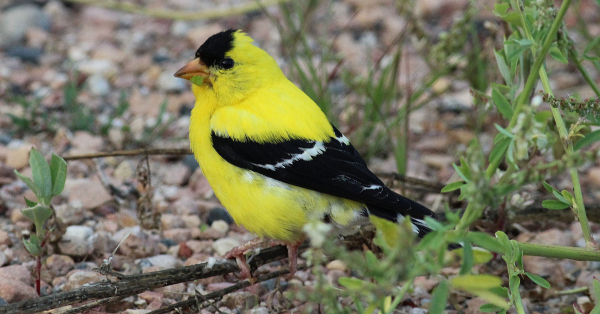
A male American Goldfinch in its colorful alternate plumage during the summer nesting period.

A male American Goldfinch beginning to molt from its basic plumage, most often noticed during the winter season, to its alternate plumage. In its basic plumage, a male could be mistaken for a female without a detailed view.
|
During late summer, after nesting, many birds molt some or all of their feathers in advance of fall migration. Molting keeps birds in top flying condition by replacing feathers that have become worn with completely new feathers. In addition to providing a new set of healthy feathers, molts often provide a new look to the bird’s plumage – even changing the dominant colors or patterns of some species, especially among adult males. Different molts can define a bird’s sex or age, thereby revealing some basic aspects of bird identification that birders use and rely on to identify birds.
Feathers are actually non-living physical material analogous to our hair or nails and made of the same basic ingredient – the protein keratin. So when feathers get damaged, they can’t heal themselves; instead, they must be replaced. If a bird loses a feather, a replacement feather will begin growing back to replace the feather, rather than waiting for the next molt.
Molting can be extremely variable; varied by species, by individuals, and from year to year. Molts can be either complete, in which the bird replaces all of its feathers during the same molt period; or they can be a partial molt, in which the bird replaces only some of its feathers during a given molt (for example, flight feathers or body feathers).
Molting takes place in response to a mixture of hormonal changes in reaction to seasonal changes. The entire process is complex and many questions remain about how the molting process is controlled. A basic understanding of molting patterns can be a useful aid in identifying many species and in determining their age, and even their sex.
Molt timing can be more complicated for larger birds, because growing larger feathers means that their molt process takes longer than it does for smaller birds. This is one reason why some birds undergo partial molts.
How often do birds molt? This varies by species, but almost all birds fall into one of the following three categories:
* One complete molt per year: Many birds, including chickadees, jays, hawks, owls, hummingbirds, flycatchers, swallows, thrushes, vireos, and woodpeckers molt once per year; usually after nesting and before fall migration.
* One complete molt and one partial molt per year: Birds in this group molt all their feathers after nesting, molting into their basic plumage. Then, before the next nesting season, they undergo a partial molt of their body feathers that gives the males their colorful alternate (breeding) plumage. Although females don’t typically molt into more colorful plumage, they do go through this same partial molt. Birds in this molt group include tanagers, warblers, and buntings.
* Two complete molts per year: Only a few species undergo two full molts per year. Most of these live in areas where the environment causes significant feather wear. Marsh Wrens and Bobolinks, two species that move through abrasive vegetation, are examples of birds that have complete molts twice per year. These birds undergo a complete molt into basic plumage after nesting; then, later in the year, they undergo another complete molt into their alternate plumage. While Marsh Wrens don’t look very different from winter to summer, male Bobolinks molt from brown and streaky basic plumage to a bold black, yellow, and white alternate plumage.
For most species, there are two primary plumage types: 1) Breeding or Alternate Plumage and 2) Winter or Basic Plumage.
While this is a good introduction to bird molting, molt patterns and their timing are complicated, and some birds’ molt patterns can be species-specific, so there is more to learn and more research to be conducted. This introduction to bird molting was based on the following article, where you can also glean some additional information: https://www.allaboutbirds.org/the-basics-feather-molt/
Share your birding experiences anytime at editors2tbw@gmail.com